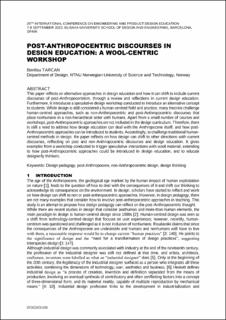| dc.description.abstract | This paper reflects on alternative approaches in design education and how it can shift to include current discourses of post-Anthropocentrism, through a review and reflections in current design education. While design is still considered a human-centered field and practice, many theories challenge human-centered approaches, such as non-Anthropocentric and post-Anthropocentric discourses that place nonhumans in a non-hierarchical order with humans. So far, with the exception of a few design courses and workshops from some universities, post-Anthropocentric approaches are not included in the current design curriculum. Therefore, there is still a need to address how design education can deal with the Anthropocene itself, and how post-Anthropocentric approaches can be introduced to students. While the foundations of industrial design education relates to craftsman traditions, for the last 50 years, it has been shifting to several directions. As Atkinson (2017) states, we are in a post profession era, and the definitions of “design”, “designer” and “professions” have become more fluid. Buchanan (1988: 66) discusses a misunderstanding that design education should follow the design practice, and states that “when properly understood and studied, design provides a powerful connective link with many bodies of knowledge. Design integrates knowledge from many other disciplines and makes that knowledge effective in practical life”: Dutton (1987) writes by exploration, that the student is not guaranteed to be a “better designer”, but “he/she has definitely begun to be a designerly thinker”. As Oxman (1999: 120) states: “if we are design educators, we must find means to supplement traditional pedagogy by educating the designerly thinker as well as the maker of designs”.“Designerly thinkers” emerge not only from designing the best possible objects at school/creating near to perfect products but from learning to develop their own methodologies while designing (Oxman, 1999: Curry, 2014). According to Findeli, design education must exceed what design is today, as the design profession can not stay as it is (2001). It is the academy’s ‘responsibility to imagine the future profile of our professions’ (2001: 17). Accordingly, the paper reflects on how design can shift to other directions with current discourses, reflecting on post and non-Anthropocentric discourses and design education. It reflects on how post-Anthropocentric approaches could be introduced in design education, to educate designerly thinkers and to challenge traditional pedagogical methods in design. Atkinson, P. (2010) Boundaries? What Boundaries? The Crisis of Design in a Post-Professional Era, The Design Journal, 13:2, 137-155. Buchanan, R. (1998). Education and professional practice in design. Design Issues, 14(2), 63–66. Curry, T. (2014). A theoretical basis for recommending the use of design methodologies as teaching strategies in the design studio. Design Studies, 35(6), 632-646 Dutton, T. (1987). Design and Studio Pedagogy. Journal of Architectural Education (1984-), 41(1), 16-25. Findeli, A. (2001). Rethinking design education for the 21st century: Theoretical, methodological, and ethical discussion. Design Issues, 17(1), 5-17. Oxman, R. (1999). Educating the designerly thinker. Design Studies, 20, 105-122. Tovey, M. (2015). Designerly thinking and creativity. In M. Tovey (Ed.), Design pedagogy: Developments in art and design education (pp. 1-14). Surrey: Gower Publishing Limited. | en_US |
